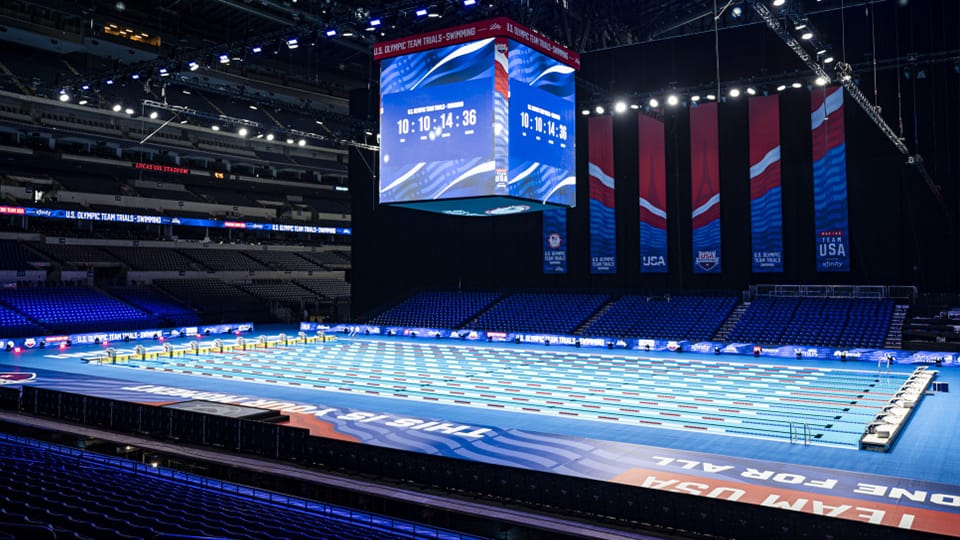Swim trials ticket sales lag expectations, but organizers predict event will break records
Subscriber Benefit
As a subscriber you can listen to articles at work, in the car, or while you work out. Subscribe Now
With the U.S. Olympic Swim Trials less than two weeks away, USA Swimming officials on Wednesday sought to make a big splash with the unveiling of the event’s pool: a million-gallon, custom-built tub of water atop the concrete floor of Lucas Oil Stadium.
But despite the novelty—it’s the first time a major swimming event has been staged inside an NFL stadium—ticket sales are still trickling in, with organizers and local officials acknowledging more must be done to meet attendance goals.
USA Swimming CEO Tim Hinchey III said he would like the event to bring in about 16,000 people per night for most of the nine-day event’s primetime slots. He has higher aims for opening night, June 15, with a goal of about 30,000 spectators—a figure that would shatter the current world record for most ticket holders at a swimming event, which is just more than 16,000.
So far, ticket sales are about halfway to that goal, at about 50%, he said. But he added he’s confident Indianapolis will get there.
“We’re in good spot where I feel really comfortable that we’re going to break the world record on opening night,” Hinchey said. “We’re going to be working hard to invite as many people [as possible]. If you have a chance to see some of the world’s greatest athletes and Olympians, I’m hoping that’ll draw some people into it. But you’ll see a lot of marketing here soon.”
Tickets to preliminary races and heats, which run in the mornings and early afternoon, start at $15 per seat for the 600 level. Evening races, which feature finals for each of the individual events and will be televised live on NBC, have tickets starting at $35 a piece.
All who attend opening night are expected to receive a T-shirt commemorating the hoped-for attendance record.
Patrick Talty, president of Indiana Sports Corp., also said he believes the low barrier for entry, paired with the numerous downtown activities associated with the event and the allure of it being nationally broadcast, will further catalyze interest in the event over the coming days.
“On overall ticket sales, when you have this many seats and are making such a big jump [in capacity], there is still inventory available,” he said. “So, we are not where we want to be because we want to fill this venue every single night and just absolutely crush it. We’ve got more tickets to sell, but we’re doing well and and it’s going to feel full. It’s going to feel exciting, electric, and people are going to be blown away. And I think that excitement and that energy is going to be something that people are going to notice.”
Despite ticket sales challenges, Indianapolis and USA Swimming stand by the decision to host the event inside Lucas Oil Stadium, rather than considering Gainbridge Fieldhouse, Talty said.
“The tickets that we’ve sold already are much more than what they would be in an arena and we need this capacity in order to host more people and give them access to experience this event,” he said. “One of the goals was to make sure that we expanded the sport of swimming and expose more people to it. That’s what we’ve done with this, and by having more inventory, it has allowed more people to be part of it.”
He said the use of Lucas Oil Stadium also allows for two warm-up pools on site—they’re on the other side of a dividing curtain between the northern and southern halves of the stadium floor—as well as a lounge for athletes and dedicated seating areas for swimmers and coaches.
Hinchey said he expects that when USA Swimming puts out a request for proposals for the 2028 trials, the focus will be on using a football stadium once again. He said while he expects Indianapolis will be in the mix for that hosting job, several other cities are sending contingents to examine how Indianapolis is conducting this year’s event to determine whether they could do the same. He added that while basketball and hockey arenas are often still in use during the summer, football stadiums are largely idle in June.
“Indiana can certainly have an opportunity for us to come back,” he said. “There’s no doubt that this is an unbelievable spectacle, right? It is really, really appealing, it’s overwhelming, it’s gratifying. I think our sport does deserve this opportunity, and I am confident that we’re going to see people come in and support this the way we want them to. This could be the floor, that we build on from here. I think we’ll see more cities interested in bringing this to their markets.”
